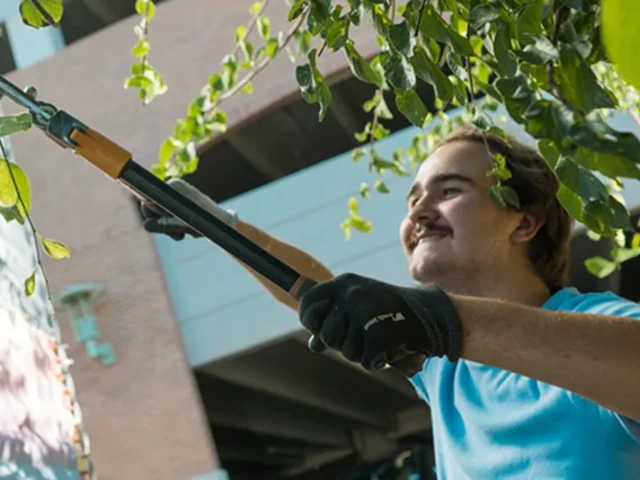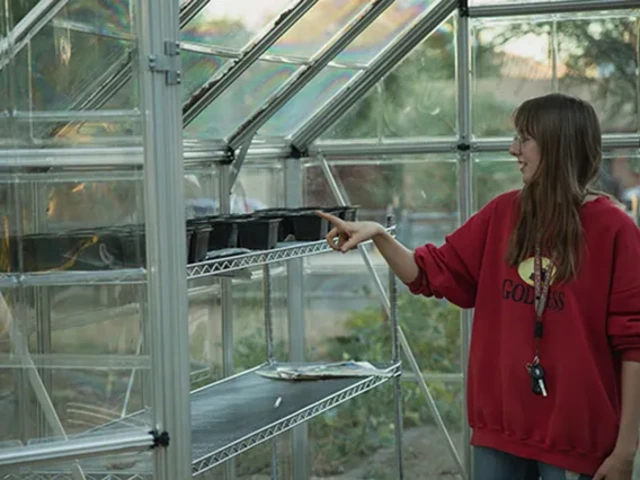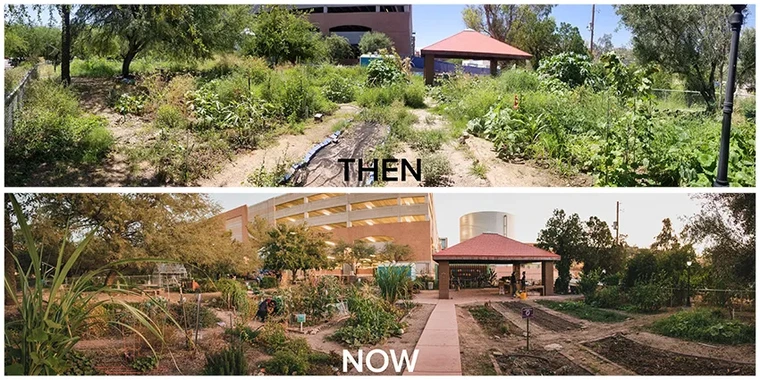Welcome to the U of A Community Garden
A space for hands-on green learning in sustainable gardening practices and community engagement.
University of Arizona Community Garden
Come Get Your Hands Dirty!

Become a Gardener

Explore the Features of Our Garden

Programming Through the Garden
About the Garden
The Garden was founded in 2012 by Students for Sustainability (SFS), the largest student sustainability program at the University of Arizona, and came under the full management of the Office of Sustainability in 2023. Located at 1400 E. Mabel Street, the Garden serves as a living laboratory for hands-on green learning and experiences in sustainable practices. It provides a unique meeting space on the University of Arizona campus that fosters relationship building and closer connections with nature.
We encourage you to come visit and get involved! Gardening has many benefits for your health and wellbeing, and it's also a great opportunity to learn about nature, healthy food systems, and what it means to grow crops in an arid environment. The Garden offers community members and students alike an opportunity to grow their food and discover sustainable gardening practices. Garden staff and volunteers maintain the Garden and provide gardeners with the resources needed to grow organic crops in Tucson's challenging climate. Even if it is your first-time gardening, we can provide you with the resources needed to get you started with growing your own produce. To learn more about the resources you get as a gardener, check out our Garden Features.
History: Our Roots Grow Deep

The Garden has been one of the only urban agricultural spaces for the University of Arizona since its founding. In 2022, the Garden celebrated its 10th anniversary! Since the Garden’s inception, it has been mainly student volunteers who have overseen the daily maintenance and operation of the Garden. In its early years, the Garden relied primarily on grant funding from the University of Arizona Green Fund, as well as rental fees collected from tenants, to maintain daily operations. However, as the Garden grew, so did a backlog of essential renovations, which were delayed by the cost of maintenance and equipment. Likewise, after an unfortunate series of burglaries and vandalism events and underfunding over the years, the Garden required some much-needed revitalization!
In Fall 2019, the Office of Sustainability took the lead in assisting Students for Sustainability in the revitalization of the Garden, working closely with Facilities Management and Planning, Design, & Construction through this process. Since then, more than $50,000 has been invested. This allowed renovations including bringing the Highland Garage Water Harvesting Cistern back to operation, installing ADA accessible paths throughout the Garden, maintaining a permanent composting system, improving the perimeter of the Garden dramatically, purchasing a new toolshed, and installation of a produce sink and water fountain.
In Fall 2020, the Garden came under the operational and financial management of the Office of Sustainability with the hands-on support still coming from the Garden Committee of SFS. During Summer 2023, the Garden transitioned into a fully-fledged, stand-alone program within the Office of Sustainability. The office employs two Student Garden Managers who help to manage 10-20 Garden volunteers, including University students and Tucson community members. Together, they support the year-round maintenance of the Garden and foster relationships with countless organizations that continually improve the Garden.
Come Say Hi!
The Garden is located at 1400 East Mabel St. We hope to see you soon!
Supporting the Garden
If you would like to support student involvement in the Garden, please consider donating to our Student Garden Fund. Donations will be used to reduce or offset the cost for students to rent a plot in the Garden. Thank you for your support!
Contact Us
If you are interested in becoming a gardener, please fill out our interest form or contact our Community Compost & Garden Coordinator, Nat Schwark at SBLY-Garden@arizona.edu or 520-626-2008. Be sure to follow us on Instagram at @uarizona_garden.
